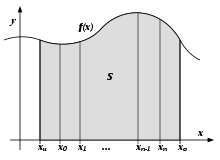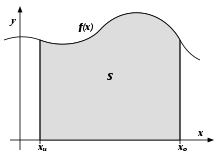Numerical integration
In numerical mathematics, numerical integration (traditionally also called numerical quadrature) refers to the approximate computation of integrals.
Often integrals cannot be solved in a closed way, because the integrand cannot be given as a primitive function or it is only given by discrete values, e.g. measurements. Then one tries to determine approximate values.
For this purpose, the integral of a function 
![[a,b]](https://www.alegsaonline.com/image/9c4b788fc5c637e26ee98b45f89a5c08c85f7935.svg)



The idea of numerical computation of integrals borrows directly from the definition of the Riemann integral.
Quadrature Procedure
Graphical methods
In graphical methods, the graph of the integrand is plotted in a coordinate system with linear axes and the area between the graph and the abscissa is determined.
Counting method
A particularly simple procedure is to plot the graph on graph paper and then determine the number of "square millimetre boxes" (area elements) covered by the area S. In this case, only half of the area elements through which the graph passes are counted. Here, area elements through which the graph passes are only counted by half. The approximation then results with the number of square millimeters 


Measurement
Another graphical method is the measurement of the area by means of a planimeter.
quadrature formula calculation
In general, a quadrature formula consists of a weighted sum of function values
The places 

A quadrature formula has the degree of precision (or exactness) 


Like the integral, quadrature formulas are linear operators.

interpolation points
Interpolatory quadrature formula
An important class of quadrature formulas arises from the idea of approximating the function 



with the weights
and the Lagrange polynomials
If the integration limits are support points, one speaks of closed quadrature formulas, otherwise of open ones. If the support points are chosen equidistantly, the Newton-Cotes formulas result among others. Among the closed Newton-Cotes formulas are the chordal trapezoid rule and Simpson's rule, among the open ones is the tangent trapezoid rule. The Newton-Cotes formulas for even 

Error estimation
Let ![[c,d]](https://www.alegsaonline.com/image/d85b3b21d6d891d97f85e263d394e3c90287586f.svg)
![[a,b]](https://www.alegsaonline.com/image/9c4b788fc5c637e26ee98b45f89a5c08c85f7935.svg)


![[c,d]](https://www.alegsaonline.com/image/d85b3b21d6d891d97f85e263d394e3c90287586f.svg)
![\xi(x) \in [c,d]](https://www.alegsaonline.com/image/b0da8f90ca0b2f3c921b892495e322119a8f52d6.svg)
By integration, the error formula for numerical quadrature is obtained

If 
![x \in [c,d]](https://www.alegsaonline.com/image/aef10ac7d23aac26f4cb71a2ad9745f574ca5af1.svg)


From this error formula follows the error estimate

If the function 
![[a,b]](https://www.alegsaonline.com/image/9c4b788fc5c637e26ee98b45f89a5c08c85f7935.svg)


With an intermediate ![{\displaystyle \zeta \in [c,d]}](https://www.alegsaonline.com/image/00492f201eff1c3fa7019ce80a7e4fd75305ab76.svg)
Similar formulas for the quadrature error are also obtained for special distributions of the grid points in the interval ![[a,b]](https://www.alegsaonline.com/image/9c4b788fc5c637e26ee98b45f89a5c08c85f7935.svg)
If the function is 
Search within the encyclopedia








